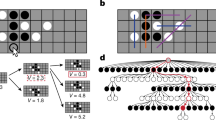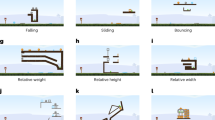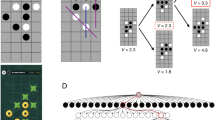Abstract
Constructing agents with planning capabilities has long been one of the main challenges in the pursuit of artificial intelligence. Tree-based planning methods have enjoyed huge success in challenging domains, such as chess1 and Go2, where a perfect simulator is available. However, in real-world problems, the dynamics governing the environment are often complex and unknown. Here we present the MuZero algorithm, which, by combining a tree-based search with a learned model, achieves superhuman performance in a range of challenging and visually complex domains, without any knowledge of their underlying dynamics. The MuZero algorithm learns an iterable model that produces predictions relevant to planning: the action-selection policy, the value function and the reward. When evaluated on 57 different Atari games3—the canonical video game environment for testing artificial intelligence techniques, in which model-based planning approaches have historically struggled4—the MuZero algorithm achieved state-of-the-art performance. When evaluated on Go, chess and shogi—canonical environments for high-performance planning—the MuZero algorithm matched, without any knowledge of the game dynamics, the superhuman performance of the AlphaZero algorithm5 that was supplied with the rules of the game.
This is a preview of subscription content, access via your institution
Access options
Access Nature and 54 other Nature Portfolio journals
Get Nature+, our best-value online-access subscription
9,800 Yen / 30 days
cancel any time
Subscription info for Japanese customers
We have a dedicated website for our Japanese customers. Please go to natureasia.com to subscribe to this journal.
Buy this article
- Purchase on SpringerLink
- Instant access to full article PDF
Prices may be subject to local taxes which are calculated during checkout



Similar content being viewed by others
Data availability
MuZero is trained only on data generated by MuZero itself; no external data were used to produce the results presented in the article. Data for all figures and tables presented are available in JSON format in the Supplementary Information.
Code availability
The Arcade Learning Environment3 is available open source at https://github.com/mgbellemare/Arcade-Learning-Environment. The Go and chess environments are available open source in OpenSpiel52 at https://github.com/deepmind/open_spiel. The pseudocode for the MuZero algorithm can be found in the file pseudocode.py in the Supplementary Information. All the neural architecture details and hyperparameters are described in Methods.
References
Campbell, M., Hoane, A. J. Jr & Hsu, F.-h. Deep Blue. Artif. Intell. 134, 57–83 (2002).
Silver, D. et al. Mastering the game of Go with deep neural networks and tree search. Nature 529, 484–489 (2016).
Bellemare, M. G., Naddaf, Y., Veness, J. & Bowling, M. The arcade learning environment: an evaluation platform for general agents. J. Artif. Intell. Res. 47, 253–279 (2013).
Machado, M. et al. Revisiting the arcade learning environment: evaluation protocols and open problems for general agents. J. Artif. Intell. Res. 61, 523–562 (2018).
Silver, D. et al. A general reinforcement learning algorithm that masters chess, shogi, and Go through self-play. Science 362, 1140–1144 (2018).
Schaeffer, J. et al. A world championship caliber checkers program. Artif. Intell. 53, 273–289 (1992).
Brown, N. & Sandholm, T. Superhuman AI for heads-up no-limit poker: Libratus beats top professionals. Science 359, 418–424 (2018).
Moravčík, M. et al. Deepstack: expert-level artificial intelligence in heads-up no-limit poker. Science 356, 508–513 (2017).
Vlahavas, I. & Refanidis, I. Planning and Scheduling Technical Report (EETN, 2013).
Segler, M. H., Preuss, M. & Waller, M. P. Planning chemical syntheses with deep neural networks and symbolic AI. Nature 555, 604–610 (2018).
Sutton, R. S. & Barto, A. G. Reinforcement Learning: An Introduction 2nd edn (MIT Press, 2018).
Deisenroth, M. & Rasmussen, C. PILCO: a model-based and data-efficient approach to policy search. In Proc. 28th International Conference on Machine Learning, ICML 2011 465–472 (Omnipress, 2011).
Heess, N. et al. Learning continuous control policies by stochastic value gradients. In NIPS’15: Proc. 28th International Conference on Neural Information Processing Systems Vol. 2 (eds Cortes, C. et al.) 2944–2952 (MIT Press, 2015).
Levine, S. & Abbeel, P. Learning neural network policies with guided policy search under unknown dynamics. Adv. Neural Inf. Process. Syst. 27, 1071–1079 (2014).
Hafner, D. et al. Learning latent dynamics for planning from pixels. Preprint at https://arxiv.org/abs/1811.04551 (2018).
Kaiser, L. et al. Model-based reinforcement learning for atari. Preprint at https://arxiv.org/abs/1903.00374 (2019).
Buesing, L. et al. Learning and querying fast generative models for reinforcement learning. Preprint at https://arxiv.org/abs/1802.03006 (2018).
Espeholt, L. et al. IMPALA: scalable distributed deep-RL with importance weighted actor-learner architectures. In Proc. International Conference on Machine Learning, ICML Vol. 80 (eds Dy, J. & Krause, A.) 1407–1416 (2018).
Kapturowski, S., Ostrovski, G., Dabney, W., Quan, J. & Munos, R. Recurrent experience replay in distributed reinforcement learning. In International Conference on Learning Representations (2019).
Horgan, D. et al. Distributed prioritized experience replay. In International Conference on Learning Representations (2018).
Puterman, M. L. Markov Decision Processes: Discrete Stochastic Dynamic Programming 1st edn (John Wiley & Sons, 1994).
Coulom, R. Efficient selectivity and backup operators in Monte-Carlo tree search. In International Conference on Computers and Games 72–83 (Springer, 2006).
Wahlström, N., Schön, T. B. & Deisenroth, M. P. From pixels to torques: policy learning with deep dynamical models. Preprint at http://arxiv.org/abs/1502.02251 (2015).
Watter, M., Springenberg, J. T., Boedecker, J. & Riedmiller, M. Embed to control: a locally linear latent dynamics model for control from raw images. In NIPS’15: Proc. 28th International Conference on Neural Information Processing Systems Vol. 2 (eds Cortes, C. et al.) 2746–2754 (MIT Press, 2015).
Ha, D. & Schmidhuber, J. Recurrent world models facilitate policy evolution. In NIPS’18: Proc. 32nd International Conference on Neural Information Processing Systems (eds Bengio, S. et al.) 2455–2467 (Curran Associates, 2018).
Gelada, C., Kumar, S., Buckman, J., Nachum, O. & Bellemare, M. G. DeepMDP: learning continuous latent space models for representation learning. Proc. 36th International Conference on Machine Learning: Volume 97 of Proc. Machine Learning Research (eds Chaudhuri, K. & Salakhutdinov, R.) 2170–2179 (PMLR, 2019).
van Hasselt, H., Hessel, M. & Aslanides, J. When to use parametric models in reinforcement learning? Preprint at https://arxiv.org/abs/1906.05243 (2019).
Tamar, A., Wu, Y., Thomas, G., Levine, S. & Abbeel, P. Value iteration networks. Adv. Neural Inf. Process. Syst. 29, 2154–2162 (2016).
Silver, D. et al. The predictron: end-to-end learning and planning. In Proc. 34th International Conference on Machine Learning Vol. 70 (eds Precup, D. & Teh, Y. W.) 3191–3199 (JMLR, 2017).
Farahmand, A. M., Barreto, A. & Nikovski, D. Value-aware loss function for model-based reinforcement learning. In Proc. 20th International Conference on Artificial Intelligence and Statistics: Volume 54 of Proc. Machine Learning Research (eds Singh, A. & Zhu, J) 1486–1494 (PMLR, 2017).
Farahmand, A. Iterative value-aware model learning. Adv. Neural Inf. Process. Syst. 31, 9090–9101 (2018).
Farquhar, G., Rocktaeschel, T., Igl, M. & Whiteson, S. TreeQN and ATreeC: differentiable tree planning for deep reinforcement learning. In International Conference on Learning Representations (2018).
Oh, J., Singh, S. & Lee, H. Value prediction network. Adv. Neural Inf. Process. Syst. 30, 6118–6128 (2017).
Krizhevsky, A., Sutskever, I. & Hinton, G. E. Imagenet classification with deep convolutional neural networks. Adv. Neural Inf. Process. Syst. 25, 1097–1105 (2012).
He, K., Zhang, X., Ren, S. & Sun, J. Identity mappings in deep residual networks. In 14th European Conference on Computer Vision 630–645 (2016).
Hessel, M. et al. Rainbow: combining improvements in deep reinforcement learning. In Thirty-Second AAAI Conference on Artificial Intelligence (2018).
Schmitt, S., Hessel, M. & Simonyan, K. Off-policy actor-critic with shared experience replay. Preprint at https://arxiv.org/abs/1909.11583 (2019).
Azizzadenesheli, K. et al. Surprising negative results for generative adversarial tree search. Preprint at http://arxiv.org/abs/1806.05780 (2018).
Mnih, V. et al. Human-level control through deep reinforcement learning. Nature 518, 529–533 (2015).
Open, A. I. OpenAI five. OpenAI https://blog.openai.com/openai-five/ (2018).
Vinyals, O. et al. Grandmaster level in StarCraft II using multi-agent reinforcement learning. Nature 575, 350–354 (2019).
Jaderberg, M. et al. Reinforcement learning with unsupervised auxiliary tasks. Preprint at https://arxiv.org/abs/1611.05397 (2016).
Silver, D. et al. Mastering the game of Go without human knowledge. Nature 550, 354–359 (2017).
Kocsis, L. & Szepesvári, C. Bandit based Monte-Carlo planning. In European Conference on Machine Learning 282–293 (Springer, 2006).
Rosin, C. D. Multi-armed bandits with episode context. Ann. Math. Artif. Intell. 61, 203–230 (2011).
Schadd, M. P., Winands, M. H., Van Den Herik, H. J., Chaslot, G. M.-B. & Uiterwijk, J. W. Single-player Monte-Carlo tree search. In International Conference on Computers and Games 1–12 (Springer, 2008).
Pohlen, T. et al. Observe and look further: achieving consistent performance on Atari. Preprint at https://arxiv.org/abs/1805.11593 (2018).
Schaul, T., Quan, J., Antonoglou, I. & Silver, D. Prioritized experience replay. In International Conference on Learning Representations (2016).
Cloud TPU. Google Cloud https://cloud.google.com/tpu/ (2019).
Coulom, R. Whole-history rating: a Bayesian rating system for players of time-varying strength. In International Conference on Computers and Games 113–124 (2008).
Nair, A. et al. Massively parallel methods for deep reinforcement learning. Preprint at https://arxiv.org/abs/1507.04296 (2015).
Lanctot, M. et al. OpenSpiel: a framework for reinforcement learning in games. Preprint at http://arxiv.org/abs/1908.09453 (2019).
Acknowledgements
We thank L. Bennett, O. Smith and C. Apps for organizational assistance; K. Kavukcuoglu for reviewing the paper; T. Anthony, M. Lai, N. Tomasev, U. Paquet, S. Ghaisas for many discussions; and the rest of the DeepMind team for their support.
Author information
Authors and Affiliations
Contributions
J.S., I.A., T.H. and D.S. designed the MuZero algorithm with advice from A.G., K.S., L.S., E.L., T.L. and T.G.; J.S., I.A., T.H. and S.S. implemented the MuZero program, ran experiments and analysed data. D.S., J.S., I.A. and T.H. wrote the paper with contributions from A.G., K.S., L.S., E.L., T.L., T.G. and D.H.
Corresponding author
Ethics declarations
Competing interests
DeepMind filed Greek patent GR20200100037 on 28 January 2020, covering the MuZero algorithm described in this paper, listing the authors J.S., I.A. and T.H. as inventors. The other authors declare no competing interests.
Additional information
Peer review information Nature thanks Jaap van den Herik and the other, anonymous, reviewer(s) for their contribution to the peer review of this work.
Publisher’s note Springer Nature remains neutral with regard to jurisdictional claims in published maps and institutional affiliations.
Supplementary information
Supplementary Information
This file contains Supplementary Figures S1-S5 and Supplementary Tables S1-S2.
Supplementary Data
The ZIP file contains Supplementary Data.
Rights and permissions
About this article
Cite this article
Schrittwieser, J., Antonoglou, I., Hubert, T. et al. Mastering Atari, Go, chess and shogi by planning with a learned model. Nature 588, 604–609 (2020). https://doi.org/10.1038/s41586-020-03051-4
Received:
Accepted:
Published:
Issue Date:
DOI: https://doi.org/10.1038/s41586-020-03051-4
This article is cited by
-
Reinforcement Learning-Based Energy Management for Hybrid Power Systems: State-of-the-Art Survey, Review, and Perspectives
Chinese Journal of Mechanical Engineering (2024)
-
On computational models of theory of mind and the imitative reinforcement learning in spiking neural networks
Scientific Reports (2024)
-
Enabling target-aware molecule generation to follow multi objectives with Pareto MCTS
Communications Biology (2024)
-
Complex behavior from intrinsic motivation to occupy future action-state path space
Nature Communications (2024)
-
Discovering neural policies to drive behaviour by integrating deep reinforcement learning agents with biological neural networks
Nature Machine Intelligence (2024)



